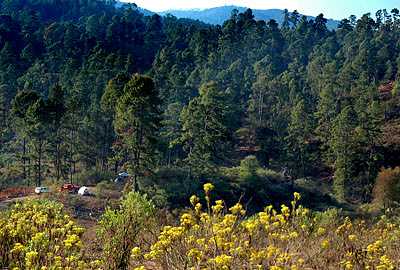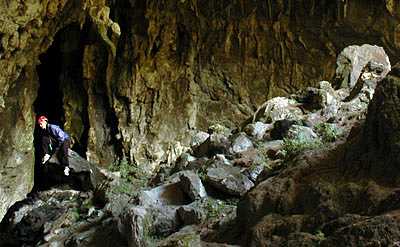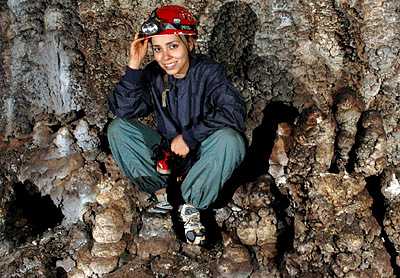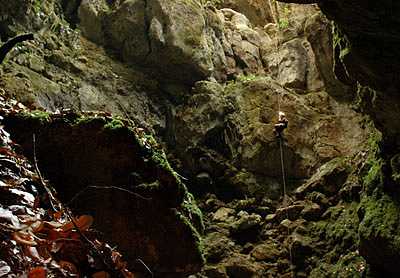Camp Dos Aguas in
the Pine-covered hills of Michoacan.

Zotz Trip Report
DOS AGUAS 2006
Updated in 2013...and still just as exciting!
While everybody else in Guadalajara went to the beach for Semana Santa, Zotz cavers headed for the pine-covered mountains of Michoacán to spend their vacation days pushing cold, muddy passages in the hope of expanding la Cueva del Río Durazno, which is already over 3 km long.
Chris Lloyd, Sergi Gómez and Victor Zaragoza led the First Wave, testing out a new route to this area, which is truly in the middle of nowhere. Victor called us from Coalcomán saying the road they took had not lived up to their expectations and Sonia Calvillo and I decided to go via Colima City and Estapilla. We were the Second Wave and had an easy drive except for an unintentional snails-pace visit to downtown Cd Guzman along the way. Of course, the fact that Sonia can’t drive her Cherokee uphill at more than 2 kph added several hours to the journey. But we were in no hurry and even stopped along the way to take samples of the local rock, which looked like very nice limestone...
| ...
At last, we pulled into camp just as the sun was about to set.
|
 |
Next day, I guarded the camp until the Third Wave arrived at noon, after having set out at 5 AM. This contingent consisted of Alberto Cortés, his wife Clementina, Rosa and Mara, who pitched their tents and went off to visit a few easy-to-reach caves.
CAVE OF THE FALLEN MAN
The following morning, Victor stood guard (which basically consists of shooing away the cows) and I took Clem, Rosa and Mara to La Cueva del Caido while everyone else worked inside La Cueva Esperanza, contorting their bodies into pretzels in order to squeeze through the narrow, muddy passages, following blowing cold air.
I was supposed to rig a cable ladder for the three women to visit the cave and they were supposed to show me its location, as they had been to the entrance the afternoon before. “Just look for a watering trough,” said Chris—the cave is nearby…you can’t miss it.”
|
Finally, we backtracked to the
drinking trough and sure enough, found Caido Cave right away. Next we
took pictures inside the impressive cave entrance...
|
 |
I rigged a cable ladder for a small drop down to the cave proper. That’s when I discovered my three companions had lights, but no helmets or even jackets. Therefore, we all took turns climbing down with the same helmet (mine). This brought us to a room where we found a few bones. Since this was La Cueva del Caido (Cave of the Man Who Fell), we wondered if these were human bones, but later learned that the unfortunate “Caido” had fallen through a skylight entrance which we never came upon.
We followed a passage off to the right and were all amazed at the wall-to-wall speleothems we found: stalactites and stalagmites by the hundreds and occasional columns with strange shapes, tilted at crazy angles. This wonderful show went on for as along as we walked (maybe 300 meters) and we came to several side passages that looked just as beautiful.
|
|
 |
That night around the campfire, we described the beauties of “Caido” Cave while the exhausted members of the Esperanza crew told tales of a tight, muddy crawlway shaped like the number four, into which shape you had to contort your body in order to get through.
The following is a short report on Esperanza Cave, The Cave of Good Hope, by Sergi Gómez, translated from the original Spanish
THE CAVE OF GOOD HOPE
By Sergi Gómez
The exploration of La Cueva Esperanza proved to be a challenge for our team due to the technical difficulties of getting into it. In this sense, it resembled European caves, which are often trickier than those in Mexico, and it took us two days of hard work just to reach the horizontal part of the cave.
On April 12 the team consisted of Chris Lloyd and Sergi Gómez, this time prepared for vertical exploration. Just as any caver would do, we decided to follow the air current. We rigged a 5 m pitch and reached a labyrinth of narrow passages which really slowed us down. After removing 50 cm of mud, we entered a somewhat wider passage but this led us to what we now call the “four,” which refers to the shape the passage took and which our bodies had to take as well. We needed all the skills of a contortionist to get past two right angles in a passage only 50 cm wide and 1 m high.
Once we got past these tight squeezes we came upon yet another technical problem: the opening to the next drop (12 m deep) was only 25 cm wide! This we eventually managed to widen with the help of a hammer, but even so, it took Sergi four tries to get through it and he was the only one able to go on ahead. Sergi found a comfy pit on the other side, four meters in diameter. This led to a room with two passages, each of which had a new pitch to negotiate. All in all, due to these various problems, we were able to map only a miserable 20 m of cave, but at least we had opened things up for the next team.
This same day, we also clarified the question of the other passage just beyond the cave entrance. We dropped the pitch in that passage and found it brought us to a dead end. On day three, April 13, the team got through the obstacle course at the entrance in a mere 25 minutes…but don’t forget we are talking about a distance of only 30 m! At last we reached the point where we could enjoy “typical Mexican cave exploration,” and after a little drop of 5 m, the team of Víctor Zaragoza, Sonia Calvillo and Sergi Gómez mapped nearly 400 m of passages during four hours. These passages were of a good size and we left various side passages unexplored (vertical ones in particular) as we moved along. Exiting the cave, the team was euphoric, believing that “La Esperanza” was going to be the cave which would reconnect us to famous Durazno Cave.
The last day of exploration was April 15. With hopes of finding more cave, we checked out some of the unknown and unexplored passages which we had come upon so far. Víctor Zaragoza, Alberto Cortés y Sergi Gómez dropped several drops and on one occasion found what looked like a river. This passage was totally atypical of the rest of the cave whose main feature was mud and more mud. Here was the beginning of a passage washed clean by running water. Our hopes ran high but did not last long as this passage came to an end 20 m farther on, entirely blocked by great plugs of mud. After this disappointment, the team went back and checked out more unexplored passages, seen the previous days. This was not terribly successful, but they managed to map another 100 m and to connect the upper passage with the lower one. Three pits still remain to be explored and several walls should be scaled, even though it will be tough to climb them as they are covered with mud. This job will be waiting for the next expedition.
A VISIT TO THE MOON
The day before we broke camp, Chris offered to take Sonia and me down into La Cueva de al Luna Llena, whose entrance is a 40-m-deep pit, reputedly one of the most photogenic pits around. As this cave requires several rebelays, Chris hinted (in his typically diplomatic way) that I should not have “all that stuff” hanging from my neck, as I myself might end up hanged. Thus, I haven’t any photos of our descent, but am still alive to tell the tale.
First, we half walked, half rappeled down two ropes tied between trees on the extremely steep slope. Then we came to a protected rope going over a lip. This was Sonia’s first experience at removing and replacing a wrap-around rope protector. I figured this was a free fall drop straight to the bottom, but a moment after Sonia disappeared over the edge, I heard “What? Another fraccionamiento?”
Non-US cavers, of course, adore fraccionamientos (rebelays) and always use as many as possible. The idea is that it’s much more exciting to go down and up a skinny little 9 mm rope that kind of makes you feel your life is hanging from a piece of spaghetti. They wouldn’t think of using a nice, thick 11 mm rope right from the top of the pit down to the floor, with several strategically placed pads. That would eliminate all the rebelays and, of course, all the fun of rigging!
After passing said rebelays, we arrived at the impressive cave entrance and wound our way through big chunks of breakdown until we reached total darkness. I spotted some nice flowstone and was about to dig the camera out of my pack when Chris said, “No, no, wait till you see the good stuff!”
The route to the good stuff included a very low belly crawl which led us to a small hole in the floor with a rope dangling above it.
|
On our way out, we paused in the
dramatic entrance for a few shots of Sonia climbing her way up the beautiful
pit.
|
 |
John Pint